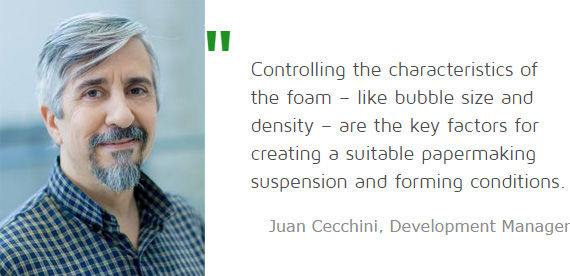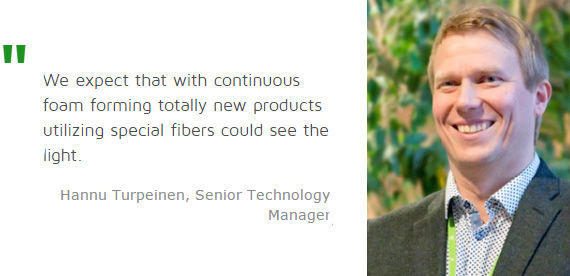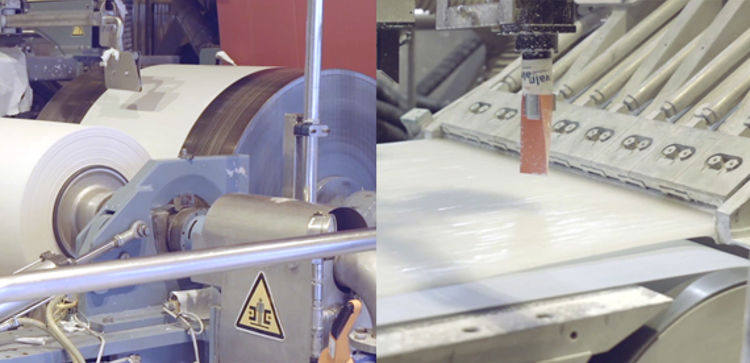Save raw materials with foam forming in paper and board making
Apr 29, 2016
Are there new ways to create a lighter board or paper products? Can you save on raw materials at the same time? Could you use less refined pulps with excellent formation and reduce energy consumption? These are questions that Valmet’s research and development experts ask themselves every day. The latest results show that these claims could turn into reality by using foam forming for more sustainable papermaking.

"Our research and development work focuses on improving energy and raw material efficiency of the paper or board machine. We believe that foam forming technology has a lot to offer in that sense,” explains Sami Anttilainen, Vice President of Technology at Valmet. “In recent years, we have been actively studying foam forming in a laboratory environment, as well as in our pilot machines in Finland. To speed up the research, we have cooperated with VTT Technical Research Centre of Finland. Partnering with VTT was a natural choice for us, as we have a long and successful history to test and do research together,” he continues.

“Foam forming is actually nothing new in the market. It has conventionally been used in the non-woven industry. Our recent studies indicate that foam forming has several benefits also in boardmaking compared to conventional water forming. The modifications needed to convert a machine for foam production are quite cost-effective,” says Hannu Turpeinen, Senior Technology Manager.
Foam on top of your beer?
“Yes, there is foam on top of beer,” laughs Development Manager Juan Cecchini, “But that kind of foam is not suitable for papermaking because of the phase separation that takes place. For papermaking, you need foam that is a simple combination air, water and the fiber suspension. If you mix it in the right way and then add a little bit of ‘magic powder,’ like a foaming agent, it helps to bind the bubbles and trap the air in in the multiphase liquid.”
Online foam creation is done with an injector mixer in the approach flow system. For a stable process, a method of disposing of drained foam is also needed, as well as reliable measurements for foam density and fluid flows. “Controlling the characteristics of the foam – like bubble size and density – are the key factors for creating a suitable papermaking suspension and forming conditions,” Cecchini adds.

Raw material savings?
“The attractive benefit of foam forming is that you can reduce the headbox flow while increasing the consistency and still handling the formation of the paper,” explains Cecchini. The stock contains large amounts of air and the fibers are distributed more evenly in the web, improving the formation of board and resulting in more consistent properties and appearance. The most interesting benefit is that the structure of e.g. cartonboard could become bulkier, allowing more lightweight products. When you look at the bottom line, the technology may reduce the use of raw materials and energy, enhancing sustainability.
“Foam forming can be applied to several products,” says Turpeinen. “Foam forming could benefit grades where bulk is a critical asset, like cartonboards. With foam, bulkier end product can be achieved and the product can be made lighter. Products like specialty papers or products with a high amount of synthetic fibers could benefit from the improved formation that foam forming permits. We also expect that with continuous foam forming, totally new products utilizing special fibers could see the light, for example.

Seeing is believing
Valmet has an extensive set of pilot facilities that it uses for demonstration trials and specific projects with customers, as well as for research. “For us, a pilot machine is a must,” Cecchini tells us. “People are naturally skeptical about new things. If you can test and demonstrate things under realistic process conditions, that helps with development, and also makes it easier for our customers to see the benefits of new technology. It shows how they can achieve their targets.”
Although foam forming is not yet a ready-wrapped package that you can just take off the shelf and start using right away, the benefits are clear: “At Valmet, we believe in foam forming technology and the new possibilities it offers our customers. Does it really save energy and raw materials? Yes, at least at pilot scale. Hopefully, we will soon confirm the results at production scale as well. After we have solved the remaining challenges, we will see if this really will be a breakthrough innovation in the paper industry,” Sami Anttilainen concludes and invites all to start exploring the possibilities of foam forming with pilot trials at Valmet’s Technology Center.

Foam forming can be tested with pilot PM at Valmet’s Technology Center.